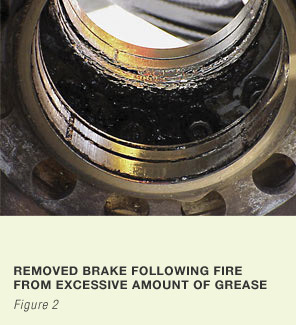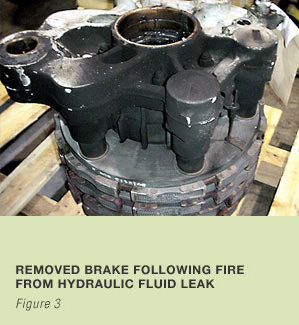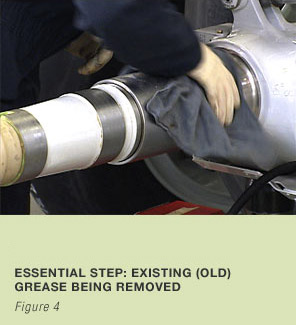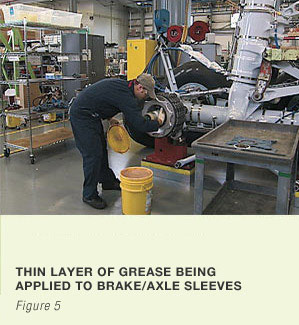
WHAT CAUSES WHEEL/BRAKE-AREA FIRES
Wheel/brake-area fires are typically caused by a buildup of grease on the axle during service or the application of excessive amounts of grease during wheel/tire changes and brake installations, and the presence of a heat source, namely the brakes. During brake lubrication, excessive grease can also collect in the cavity between the piston housing and torque tube pedestal bushing due to a damaged or missing grease seal or excessive lubrication through the brake piston housing axle bushing lubrication fitting.
Wheel/brake-area fires have also been linked to cleaning fluids retained in the heat shield. Some heat shield designs can absorb cleaning solvents, causing the shield to become saturated with flammable cleaning fluids if they are sprayed or immersed during cleaning.
During normal braking on landing, the temperatures in the main landing gear wheel/brake area can cause grease and residual cleaning fluids in these areas to ignite. Carbon brakes normally operate at slightly higher temperatures than steel brakes, which explains why nearly all reports are associated with carbon brakes. These types of wheel/brake-area fires usually occur within the first few cycles following a wheel or brake change, or following lubrication of the piston-housing grease fitting when a grease seal is damaged or missing. Fires due to leaking hydraulic system components can occur immediately following fluid spillage onto a hot brake.
PREVENTING WHEEL/BRAKE-AREA FIRES
Because their cause is well known, wheel/brake-area fires can be prevented by following proper maintenance procedures. These include:
- Cleaning existing grease from the axle. When removing or installing wheels and brakes, it is essential to remove old grease from the axle (see fig. 4). Because cleaning fluids and solvents can damage carbon brakes and titanium components, a dry rag must be used to remove the grease.
- Removing old grease from the axle every time wheels and brakes are installed or removed.
- Using only approved greases in small quantities. While it is important to have adequate lubrication within the wheel bearings, only a thin layer of grease is necessary at the wheel/axle interface for wheel/tire installations. Similarly, only a thin layer of grease needs to be applied to the interface surfaces of the brake and axle sleeves when installing brakes (see fig. 5). When applying grease to the axle bushings on the brake assembly, it is important to completely fill the grooves in the bushings with grease.
- Being certain that the brake axle bushing grease seal (on airplanes that have them) is not damaged before installing brakes and that the grease seal is properly installed per the applicable Airplane Maintenance Manual (AMM) or CMM instructions.
- Following wheel supplier CMM cautions when cleaning wheel heat shields. The main wheel heat shield must be cleaned by following the manufacturer's recommended maintenance procedures in the appropriate supplier CMM. Spraying or immersing certain heat-shield designs in cleaning fluids can trap residual fluids within the shield, which can lead to a subsequent fire. The wheel heat shields should be removed according to the supplier CMM during wheel-cleaning operations.




